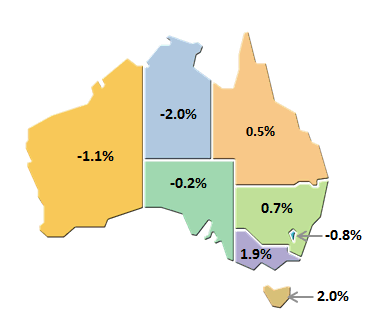MAIN FEATURES STATE FINAL DEMAND CHAIN VOLUME MEASURES
 |  | Seasonally adjusted, % change from Dec 17 to Mar 18 |
 |  |
|
 |  | NSW | Vic. | Qld | SA | WA | Tas. | NT | ACT | Aust.(a) |
 |  |  |  |  |  |  |  |  |  |  |
|
| Final consumption expenditure |  |  |  |  |  |  |  |  |  |
 | General government | 2.6 | 2.2 | 1.2 | 1.4 | 0.1 | 3.1 | 1.4 | -2.1 | 1.6 |
 | Households | 0.4 | 0.5 | 0.3 | 0.2 | -0.1 | -0.4 | 0.3 | 0.2 | 0.3 |
| Gross fixed capital formation |  |  |  |  |  |  |  |  |  |
 | Private | 0.3 | 8.1 | -0.2 | -0.8 | -4.0 | 9.9 | -7.7 | -0.8 | 1.2 |
 | Public | -1.1 | -5.0 | 2.5 | -9.4 | -2.1 | 3.8 | -3.9 | 1.1 | -2.0 |
| State final demand | 0.7 | 1.9 | 0.5 | -0.2 | -1.1 | 2.0 | -2.0 | -0.8 | 0.6 |
|
| (a) Australia estimates relate to Domestic final demand. |
MARCH QUARTER
Summary Comments
Australia
- Australian domestic final demand increased 0.6% in the March quarter 2018. State final demand increased in New South Wales, Victoria, Queensland and Tasmania while decreases were seen in South Australia, Western Australia, the Northern Territory and the Australian Capital Territory.
STATE FINAL DEMAND, Quarterly Volumeámeasures
: Seasonally adjusted

New South Wales
- New South Wales' state final demand increased 0.7% in the March quarter and follows a 1.1% increase in the December quarter. Household and government final consumption expenditure drove the growth in state final demand. Private capital investment also increased in NSW but had a very small contribution to growth. Public capital investment detracted slightly from growth driven by the general government sector.
Victoria
- Victoria's state final demand increased 1.9% in the March quarter and follows a 0.4% increase in the December quarter. Private gross fixed capital formation was the strongest contributor to growth driven by non-dwelling construction. Household final consumption expenditure and government final consumption expenditure also contributed solidly. Conversely, public gross fixed capital formation detracted from growth in the quarter, driven by state and local general government capital formation.
Queensland
- Queensland's state final demand increased 0.5% in the March quarter and follows a 1.1% increase in the December quarter. Household and government final consumption expenditure drove the growth in state final demand. Public capital investment also increased in Queensland. Private capital investment detracted from growth driven by dwelling construction and expenditure on machinery and equipment but partially offset by an increase in non-dwelling construction.
South Australia
- South Australia's state final demand decreased 0.2% in the March quarter following a 1.3% increase in the December quarter. The fall was primarily driven by weakness in public gross fixed capital formation. Private gross fixed capital formation also contributed to the fall. Government final consumption expenditure partially offset this fall driven by state and local government, along with a small contribution to growth from household final consumption expenditure.
Western Australia
- Western Australia's state final demand decreased 1.1% in the March quarter following a revised increase of 0.5% in the December quarter. The fall in the March quarter was driven by reduced private capital investment. There was a large fall in non-dwelling construction combined with a smaller fall in expenditure on machinery and equipment. Public capital investment also decreased over the quarter driven by the general government sector. Government final consumption expenditure increased, but was offset by a small fall in household final consumption expenditure.
Tasmania
- Tasmania's state final demand increased 2.0% in the March quarter and follows a 0.9% increase in the December quarter. Private gross fixed capital formation contributed strongly to growth in the quarter, driven by investment in machinery and equipment. The public sector also contributed to growth through increased government final consumption expenditure, driven by state and local spending, and public gross fixed capital formation. Partially offsetting the rise was a fall in household final consumption expenditure.
Northern Territory
- Northern Territory's state final demand decreased 2.0% in the March quarter and follows a 6.0% decrease in the December quarter. The largest detractor from growth was private gross fixed capital formation driven by non-dwelling construction. Both government and household final consumption expenditure increased but public gross fixed capital formation fell in the March quarter driven by the general government sector.
Australian Capital Territory
- Australian Capital Territory's state final demand decreased 0.8% in the March quarter following a 0.8% increase in the December quarter. Government final consumption expenditure drove the contraction in the March quarter, spread across national and state and local consumption expenditure. Private capital investment also contributed to the fall, with strength in machinery and equipment expenditure not enough to offset falls in dwelling and non-dwelling construction. Public capital investment partially offset the falls with growth in public non-financial corporations. Household final consumption expenditure also rose in the quarter.
 Quality Declaration
Quality Declaration  Print Page
Print Page
 Print All
Print All